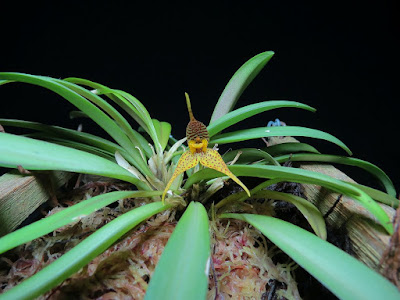Dryadella edwallii is native to Brazil. This orchid grows on trees in the cold, humid mountains of the states of Sao Paulo, Parana, Santa Catarina and Minas Gerais at elevations around 1300 meters...
Dryadella edwallii also called as Edwall's Dryadella, The Partridge in the Grass Orchid, Masdevallia edwallii, is a species of the genus Dryadella. This species was described by Carlyle A. Luer in 1978.
IDENTIFY DRYADELLA EDWALLII
Dryadella edwallii is native to Brazil. This orchid grows on trees in the cold, humid mountains of the states of Sao Paulo, Parana, Santa Catarina and Minas Gerais at elevations around 1300 meters. The plants of this type usually grow best at low to moderate temperatures and the height is adjusted.
It is a mini-miniature sized, cool growing epiphyte, which reaching 2.5 cm in height, with erect, 0.4-0.7 cm long ramicauls enveloped basally by 2 to 3 thin, tubular sheaths and carrying a single, apical, erect, leathery, linear-spathulate, obtuse, narrowing below into the base, dark green, 2-5 cm long and 0.5-0.8 cm wide leaf.
Edwall's Dryadella has a short, 2 cm inflorescence that arises from the leaf base most often during the summer but possible at other times of the year. The flowers are 2.5 to 3 cm and are hidden in a clump of leaves, but sometimes they can grow up to the tops of the leaves. The flowers are light yellow or cream-colored, densely marked with reddish-purple dots and spots. Spots on the dorsal petal are narrow, close together, irregularly shaped, form transverse strands. The triangular flakes of the outer whorl form an open goblet at their bases, then narrow to form long, sharp tips at the apexes. The straight dorsal flap is bent forward at the base, but above its center it bends so that its top is straight or slightly bent. The side outer petals have transverse gussets folded at the base, below which they combine to form a kind of chin or hollow below the base of the spine. They are slightly forward and extend diagonally at the base, but curve back and down at the apex, so that they face down and lie parallel to each other, or even converge vertices. The small, fleshy, oval petals of the inner whorl are directed forward on each side of the spine.
DRYADELLA EDWALLII CARE AND CULTURE
Cultural information should only be used as a guide, and should be to be adapted to suit you. Your physical location; where you grow your plants, how much time you have to devote to their care, and many other factors, will need to be taken into account. Only then can you decide on the cultural methods that best suit you and your plants.
Light:
Dryadella edwallii needs a light level of 12000-18000 lux. These plants require filtered or diffused light or semi-shade and should never be exposed to the direct southern sun. Strong air movement should be ensured all the time.
Temperature:
The average temperature of the summer day is 24-26 ° C, the night 17-18 ° C, and the daily difference is 7-8 ° C. The average temperature of the winter day is 19 ° C, night 12 ° C, and the daily difference is 7-8 ° C.
Humidity:
For most of the year, Edwall's Dryadella needs the humidity of 80-85%, but in winter and at the beginning of spring it drops to almost 75%.
Substrate, growing media and repotting:
Dryadella edwallii can be grown in shallow containers with perfect drainage or mounted on tree root washers. The mounted plants, however, require high humidity and during the hot, dry weather it may be necessary to water several times a day.
The can also be grown in small pots or baskets with excellent drainage, filled with very loose, quickly drying ground, which is easy to aerate. Usually, a medium-sized bark or chopped tree-fern fiber is used, with the addition of pieces of pearlite or chopped sphagnum moss, which helps to keep the substrate cool, while at the same time retaining some of the moisture. The addition of charcoal also improves the airiness of the substrate and prevents souring of the substrate.
These plants do not like moving off, so it is best to repot or divide them only when it is absolutely necessary. Since they also do not tolerate any loose soil around the roots, they must be repotted before the soil begins to decompose. That is why it is important to choose a substrate that breaks down very slowly. Repotting can be done when new roots start growing, because then the plants stabilize quite fast.
Watering:
In the natural habitat, rainfall is abundant from late spring until autumn. In autumn and winter their amount decreases, but it is not a real dry season. The cultivated plants should be abundantly watered during active growth, but excellent drainage must be ensured, and the ground around the roots can not be soggy or damp. At the end of autumn, the amount of water should be slightly reduced.
Fertilizer:
It is recommended to apply a 1/4-1/2 dose of orchid fertilizer weekly during active growth. You can use a balanced fertilizer throughout the year. You can also use high-nitrogen fertilizer from spring to mid-summer, and then until the end of autumn, high-phosphoric fertilizer.
Rest period:
In winter, Dryadella edwallii need less water, but they should never dry up completely. Fertilization should be reduced or eliminated until spring, when new growth starts and more watering is undertaken.















COMMENTS